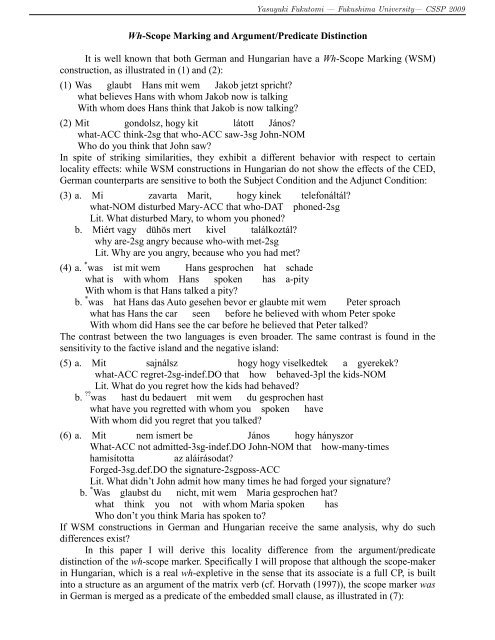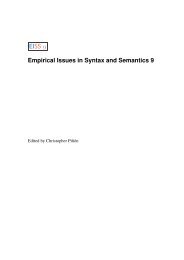Wh-Scope Marking and Argument/Predicate Distinction It is ... - CSSP
Wh-Scope Marking and Argument/Predicate Distinction It is ... - CSSP
Wh-Scope Marking and Argument/Predicate Distinction It is ... - CSSP
You also want an ePaper? Increase the reach of your titles
YUMPU automatically turns print PDFs into web optimized ePapers that Google loves.
Yasuyuki Fukutomi — Fukushima University— <strong>CSSP</strong> 2009<br />
<strong>Wh</strong>-<strong>Scope</strong> <strong>Marking</strong> <strong>and</strong> <strong>Argument</strong>/<strong>Predicate</strong> <strong>D<strong>is</strong>tinction</strong><br />
<strong>It</strong> <strong>is</strong> well known that both German <strong>and</strong> Hungarian have a <strong>Wh</strong>-<strong>Scope</strong> <strong>Marking</strong> (WSM)<br />
construction, as illustrated in (1) <strong>and</strong> (2):<br />
(1) Was glaubt Hans mit wem Jakob jetzt spricht<br />
what believes Hans with whom Jakob now <strong>is</strong> talking<br />
With whom does Hans think that Jakob <strong>is</strong> now talking<br />
(2) Mit gondolsz, hogy kit látott János<br />
what-ACC think-2sg that who-ACC saw-3sg John-NOM<br />
<strong>Wh</strong>o do you think that John saw<br />
In spite of striking similarities, they exhibit a different behavior with respect to certain<br />
locality effects: while WSM constructions in Hungarian do not show the effects of the CED,<br />
German counterparts are sensitive to both the Subject Condition <strong>and</strong> the Adjunct Condition:<br />
(3) a. Mi zavarta Marit, hogy kinek telefonáltál<br />
what-NOM d<strong>is</strong>turbed Mary-ACC that who-DAT phoned-2sg<br />
Lit. <strong>Wh</strong>at d<strong>is</strong>turbed Mary, to whom you phoned<br />
b. Miért vagy dühös mert kivel találkoztál<br />
why are-2sg angry because who-with met-2sg<br />
Lit. <strong>Wh</strong>y are you angry, because who you had met<br />
(4) a. * was <strong>is</strong>t mit wem Hans gesprochen hat schade<br />
what <strong>is</strong> with whom Hans spoken has a-pity<br />
With whom <strong>is</strong> that Hans talked a pity<br />
b. * was hat Hans das Auto gesehen bevor er glaubte mit wem Peter sproach<br />
what has Hans the car seen before he believed with whom Peter spoke<br />
With whom did Hans see the car before he believed that Peter talked<br />
The contrast between the two languages <strong>is</strong> even broader. The same contrast <strong>is</strong> found in the<br />
sensitivity to the factive <strong>is</strong>l<strong>and</strong> <strong>and</strong> the negative <strong>is</strong>l<strong>and</strong>:<br />
(5) a. Mit sajnálsz hogy hogy v<strong>is</strong>elkedtek a gyerekek<br />
what-ACC regret-2sg-indef.DO that how behaved-3pl the kids-NOM<br />
Lit. <strong>Wh</strong>at do you regret how the kids had behaved<br />
b. was hast du bedauert mit wem du gesprochen hast<br />
what have you regretted with whom you spoken have<br />
With whom did you regret that you talked<br />
(6) a. Mit nem <strong>is</strong>mert be János hogy hányszor<br />
<strong>Wh</strong>at-ACC not admitted-3sg-indef.DO John-NOM that how-many-times<br />
ham<strong>is</strong>ította az aláírásodat<br />
Forged-3sg.def.DO the signature-2sgposs-ACC<br />
Lit. <strong>Wh</strong>at didn’t John admit how many times he had forged your signature<br />
b. * Was glaubst du nicht, mit wem Maria gesprochen hat<br />
what think you not with whom Maria spoken has<br />
<strong>Wh</strong>o don’t you think Maria has spoken to<br />
If WSM constructions in German <strong>and</strong> Hungarian receive the same analys<strong>is</strong>, why do such<br />
differences ex<strong>is</strong>t<br />
In th<strong>is</strong> paper I will derive th<strong>is</strong> locality difference from the argument/predicate<br />
d<strong>is</strong>tinction of the wh-scope marker. Specifically I will propose that although the scope-maker<br />
in Hungarian, which <strong>is</strong> a real wh-expletive in the sense that its associate <strong>is</strong> a full CP, <strong>is</strong> built<br />
into a structure as an argument of the matrix verb (cf. Horvath (1997)), the scope marker was<br />
in German <strong>is</strong> merged as a predicate of the embedded small clause, as illustrated in (7):
Yasuyuki Fukutomi — Fukushima University— <strong>CSSP</strong> 2009<br />
(7) [ VP matrix verb [FOCUS [ SC [ SUBJ embedded question] [ PRED was]]]]<br />
The proposal <strong>is</strong> based on the fact pointed out by Müller(1995) that the WSM construction<br />
shares its sensitivity to locality with verb-second clause in German, <strong>and</strong> that WSM <strong>and</strong><br />
verb-second cannot occur in the same clause in German, as demonstrated in (8) <strong>and</strong> (9):<br />
(8) a. Ich glaube den Fritz mag jeder (bridge verb)<br />
I believe ART Fritz ACC likes everyone<br />
b. * Ich bedaure den Fritz mag jeder (factive verb)<br />
I regret ART Fritz ACC likes everyone<br />
c. * Mich hat überrascht den Fritz mag jeder (sentential subject)<br />
me ACC has surpr<strong>is</strong>ed ART Fritz ACC likes everyone<br />
d. * obwohl den Fritz mag jeder (adjunct)<br />
although ART Fritz ACC likes everyone<br />
(9) * Was glaubte sie wann geht er ins Wirtshaus<br />
what believed she when goes he into-the pub<br />
<strong>Wh</strong>en did she believe that he goes into the pub<br />
The above-mentioned set of data can be explained straightforwardly if the wh-scope marker<br />
<strong>and</strong> the verb compete at the same functional head. I will assume here that the relevant head <strong>is</strong><br />
the embedded FOCUS position <strong>and</strong> thus the scope marker in German <strong>is</strong> subject to severe<br />
restrictions on further movement to the spec of the matrix CP.<br />
The present analys<strong>is</strong> <strong>is</strong> corroborated by the same kind of differences observed in<br />
wh-in-situ languages such as Hindi <strong>and</strong> Japanese. <strong>Wh</strong>ile WSM constructions in Hindi do not<br />
show the factive <strong>is</strong>l<strong>and</strong> effect, Japanese counterparts are subject to the relevant <strong>is</strong>l<strong>and</strong><br />
condition. Moreover, Japanese uses the wh-phrase doo ‘how’, not nani ‘what’, as a scope<br />
marker, which <strong>is</strong> also used as a predicate in the small clause, as shown in (10):<br />
(10) a. Mary-wa [[John-ga nani-o yonda ka] doo] omotteiru no<br />
Mary-TOP John-NOM what-ACC read Q how think Q<br />
‘<strong>Wh</strong>at does Mary think that John read’<br />
b. Mary-wa [ SC John-o doo] omotteiru no<br />
Mary-TOP John-ACC how think Q<br />
‘<strong>Wh</strong>at does Mary think John (to be)’<br />
Interestingly, in both constructions the wh-phrase doo cannot be preposed to the left of the<br />
subject of the small clause, as indicated in (11):<br />
(11) a. * Mary-wa doo i [[John-ga nani-o yonda ka] t i ]omotteiru no<br />
Mary-TOP how John-NOM what-ACC read Q think Q<br />
‘<strong>Wh</strong>at does Mary think that John read’<br />
b. * Mary-wa doo i [ SC John-o t i ] omotteiru no<br />
Mary-TOP how John-ACC think Q<br />
‘<strong>Wh</strong>at does Mary think John (to be)’<br />
Th<strong>is</strong> also indicates that the scope marker <strong>is</strong> introduced into the structure as a predicate of the<br />
embedded small clause in Japanese.<br />
Summarizing, differences with respect to the sensitivity to locality observed in WSM<br />
constructions are derived from the argument/predicate d<strong>is</strong>tinction of the wh-scope marker. In<br />
th<strong>is</strong> respect, the analys<strong>is</strong> gives an additional support to the Minimal<strong>is</strong>t thes<strong>is</strong> that parametric<br />
variations should be reduced to the lexicon.<br />
References<br />
Horvath, Julia. 1997. “The Status of ‘<strong>Wh</strong>-Expletives’ <strong>and</strong> the Partial <strong>Wh</strong>-Movement<br />
Construction of Hungarian,” Natural Language <strong>and</strong> Lingu<strong>is</strong>tic Theory 15: pp.509-572.<br />
Müller, Gereon. 1995. A-bar syntax: a study in movement types. Berlin: Mouton de Gruyter.











